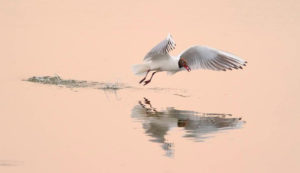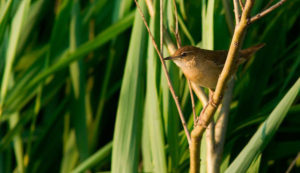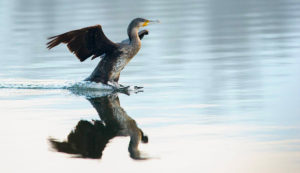This species is known for its very interesting reproductive strategy. It is a parasite in fact, since it lays its eggs in the nests of many other species.
Uccelli
The protected area is particularly important for birds, with a notable variety of environments ranging from forests to meadows, rush stands, and permanently flooded bodies of water. The number of species here therefore is very high and changes throughout the year depending on the continuous movement of these interesting animals. The Reserve is like a large international nature airport, with individuals leaving and arriving continuously. These movements follow a rough calendar. Between August and November, thousands of migratory birds pass through and often stop in the Reserve during their autumn migration southwards, with the flycatchers, warblers, and ospreys among the first to arrive.
Wintering birds can be seen between December and January. These include the grey heron, little egret, Eurasian bittern, great egret, and hundreds of cattle egrets. Ducks are clearly decreasing compared to the past. This is due to a number of local causes — such as the decrease in underwater vegetation and the presence of the wels catfish — and global causes, such as climate change.
From February to May, you can witness the spring migration northwards, with the arrival of thousands of swallows and swifts. In April, four different species of swallows and two species of swifts can be seen. From May to the beginning of July, nesting birds are present in the peat bogs, but some species start nesting as early as March and April. Those nesting early include some resident species (which remain year round) such as little grebes, grebes, or Cetti’s warblers, while migratory birds coming from the south arrive a little later. Among others, there are the reed warblers and great reed warblers in May, and western marsh harriers and black kites in April.


Western Marsh Harrier
This is a very able flyer, demonstrating the fact especially in spring, when males and females follow daring nuptial parades.

Osprey
This is a magnificent bird of prey known for its ability to grab fish with its claws while performing spectacular dives. Currently being introduced in Italy after it became extinct, a few pairs are now present in Tuscany and Sardinia.

Red-crested pochard
Once considered rare, it has become the most common duck species in the Reserve in recent years.

Black-Headed Gull
For years, gulls have been moving away from the seashores, colonizing Italian inland areas, including the Province of Brescia, especially outside the reproductive period.

Common Moorhen
This is a sedentary species, rather common and easily seen on the lake, but also in small bodies of water, trenches, or millraces.

Mallard
A common, well-known dabbling duck that represents the ‘prototype’ of domestic species.

Common Kingfisher
They are easier to see when moving from one bank to the other, but you have to be lucky, since this only takes a few seconds. A small turquoise arrow passes by, whistling just above the water, and the kingfisher has already disappeared!

Common Pochard
Since this is a gregarious species, it can be seen in groups mixed with other species, especially in autumn and winter.

Black Kite
The black kite is a bird of prey distinguished, as per its name, by its nearly uniform dark colour.

Black-Crowned Night Heron
The scientific name of this bird means ‘night raven’, since its call resembles that of a raven, which it usually emits when flying at sunset and at night.

Water Rail
It emits a sound similar to a frightened pig.

Savi’s Warbler
This bird is easier to hear than see. It emits a monotone buzz than can be confused with that of insects. It sings from the top of reeds or bushes, so you can challenge yourself by searching for this small mimetic bird.

Great Crested Grebe
They are seen almost exclusively in the water. They do not escape by flying into the air but rather dive quickly under the water.

Little Bittern
This is the smallest European heron, very adept at camouflaging itself among the rushes.

Eurasian Bittern
The elusive presence of this species is betrayed in spring by its loud call, similar to a gloomy ‘bellow’ which can even be heard a couple of kilometres away.

Cetti’s Warbler
These birds are much easier to hear than see, given that they love to be among the densest vegetation.

Great Cormorant
These are able fishing birds capable of following the fish underwater. Returning to the surface, they quickly turn the fish and swallow it head first. Since their feathers are not waterproof, they often ‘stretch out’ to dry as they rest after a dive. They open their wings and remain still until they dry.

Mute Swan

Great Reed Warbler
It is not easy to see these birds, except they are singing at the tops of the reeds or bushes. It is easier to hear their song, which consists of scraping sounds like cre-cre-cre, cri-cri, and cro-cro alternating with chattering and whistles.

Bearded Reedling
This very pretty bird is so rare and elusive that when it appears, it attracts swarms of photographers and birdwatchers.

Purple Heron
Normally silent, these birds become more talkative during the reproductive period.

Grey Heron
This is one of the largest herons. As per its name, it is grey in colour, and its neck is white with black stripes.